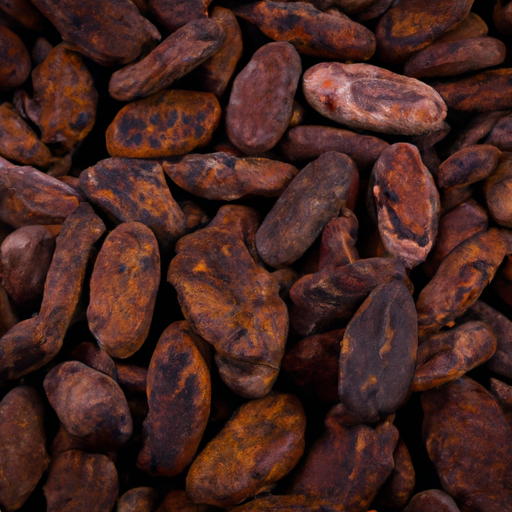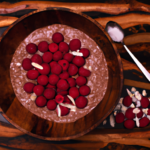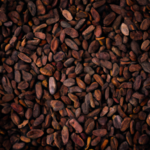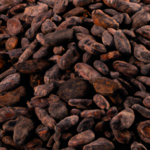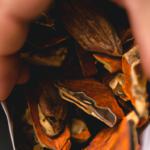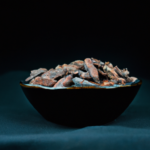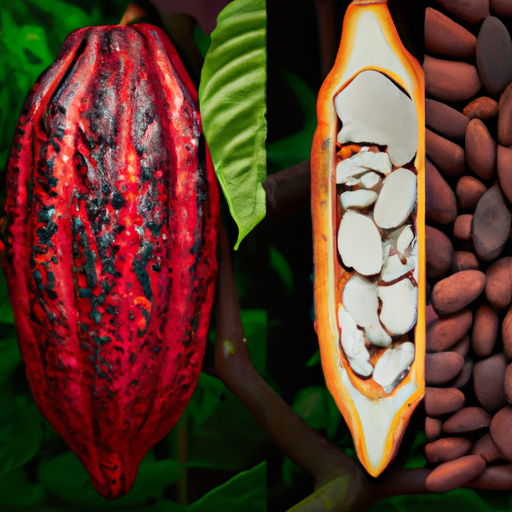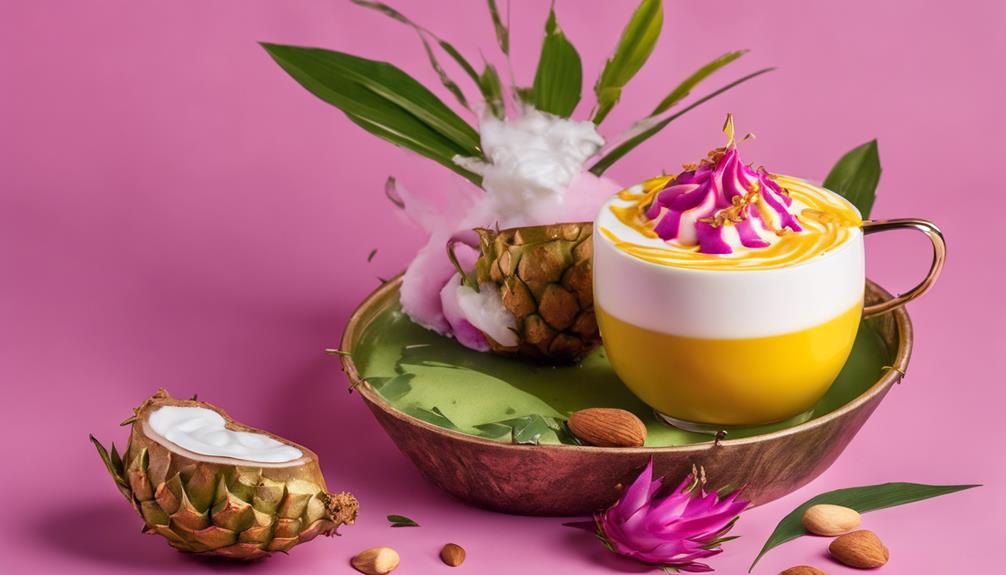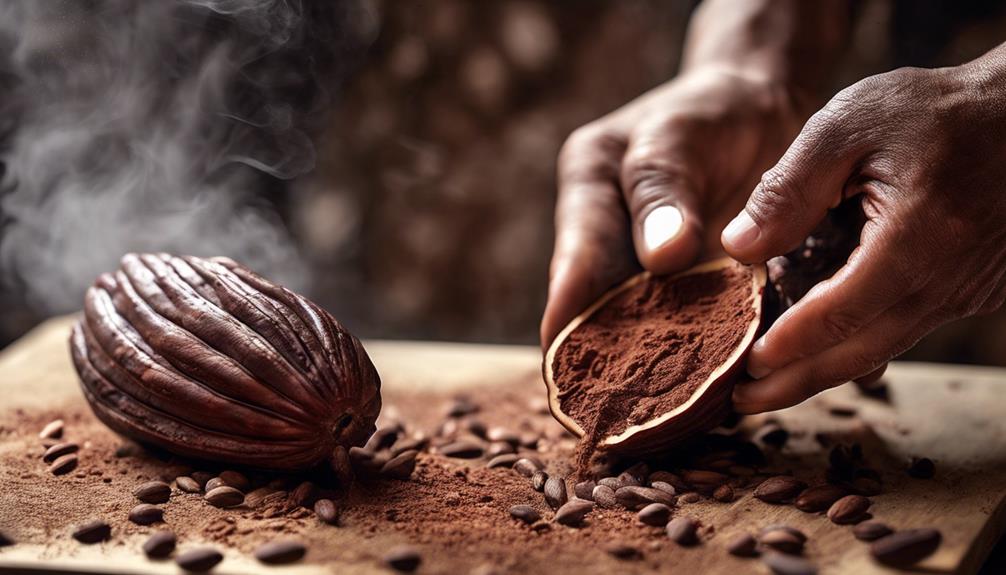Raw organic cacao nibs contain more antioxidants than blueberries, goji berries, and green tea. As a nutrition enthusiast, I am constantly seeking out superfoods that can improve my health, and cacao nibs are certainly one of them.
In this article, we will explore the origins of cacao nibs, their impressive nutritional value, and the numerous health benefits they offer. We’ll also delve into the culinary uses of cacao nibs and provide tips on how to choose and store them properly.
But that’s not all! We will also compare cacao nibs to chocolate and discuss how you can easily incorporate these crunchy little morsels into your diet. Of course, we’ll touch on some cautions and considerations to keep in mind as well.
Lastly, we’ll take a closer look at the importance of sustainable and ethical sourcing when it comes to cacao nibs. So, let’s dive in and discover why cacao nibs are becoming a popular choice for health-conscious individuals like myself.
Key Takeaways
- Raw organic cacao nibs are a delicious and nutritious treat.
- Cacao nibs can potentially trigger allergies and sensitivities, so individuals should be mindful of their reactions and consult with a healthcare professional if necessary.
- Cacao nibs can interact with certain medications, so it is important to consult with a healthcare provider if you are taking prescription medications.
- Choosing fair trade and organic certified cacao nibs supports sustainable farming practices, promotes social justice, and minimizes the environmental impact of cacao production.
The Origins of Cacao Nibs
Let’s take a journey back in time to uncover the rich and fascinating origins of cacao nibs.
The history of cacao cultivation can be traced back to ancient Mesoamerica, where the Mayans and Aztecs revered the cacao tree. They believed that cacao seeds were a divine gift from the gods and used them in religious ceremonies and as currency.
Cacao nibs, which are simply crushed cacao beans, were highly valued for their intense flavor and nutritional properties. They were often ground into a paste and mixed with water to create a frothy beverage called xocoatl, which was enjoyed by nobility and warriors.
Today, cacao nibs continue to hold cultural significance, being used in various culinary creations and enjoyed for their rich chocolate flavor.
Now, let’s delve into the nutritional value of cacao nibs.
The Nutritional Value of Cacao Nibs
Cacao nibs are known for their high antioxidant content, making them a valuable addition to a healthy diet. These antioxidants help protect the body’s cells from damage caused by harmful free radicals.
Additionally, cacao nibs are rich in essential minerals such as magnesium, iron, and zinc, which are important for various bodily functions and overall well-being.
They also provide a good source of vitamins, including vitamin E, which plays a role in maintaining healthy skin and immune function.
Antioxidant content
Indulge in the rich treasure trove of antioxidants found in raw organic cacao nibs, where your taste buds will dance with the vibrant power of nature’s protective warriors. Antioxidants play a crucial role in preventing diseases and promoting overall health. Here are four reasons why the antioxidant content of cacao nibs is beneficial:
-
Protects against oxidative stress: Antioxidants neutralize harmful free radicals, reducing oxidative stress and the risk of chronic diseases like heart disease and cancer.
-
Supports brain health: Cacao nibs contain flavanols that can improve cognitive function and protect against age-related cognitive decline.
-
Promotes heart health: Antioxidants in cacao nibs help lower blood pressure, reduce inflammation, and improve blood flow, all of which contribute to a healthy heart.
-
Boosts immune system: Antioxidants support a strong immune system, helping the body fight off infections and diseases.
Now, let’s explore the next section about essential minerals and vitamins found in cacao nibs.
Essential minerals and vitamins
One can benefit from the essential minerals and vitamins found in cacao nibs by incorporating them into their diet. Cacao nibs are a rich source of several essential minerals, including magnesium, iron, and potassium.
Magnesium plays a crucial role in various bodily functions, such as nerve function and muscle contraction. Iron is essential for the production of red blood cells and transporting oxygen throughout the body. Potassium helps maintain proper heart and muscle function.
In addition to minerals, cacao nibs also contain vitamins, including vitamin E and B vitamins. Vitamin E is an antioxidant that helps protect cells from damage, while B vitamins are important for energy production and brain health.
Incorporating cacao nibs into your diet can provide you with these essential minerals and vitamins, promoting overall health and well-being.
Moving on to the health benefits of cacao nibs, their antioxidant content is particularly noteworthy.
Health Benefits of Cacao Nibs
You won’t believe the incredible health benefits you’re missing out on if you haven’t tried these raw organic cacao nibs! These small pieces of pure cacao beans are packed with essential minerals and vitamins that can support your overall well-being. Cacao nibs are a rich source of antioxidants, which can help protect your cells from damage caused by harmful free radicals. They are also high in fiber, which aids in digestion and promotes a healthy gut. Additionally, cacao nibs contain flavanols that have been linked to improved heart health and reduced inflammation. To visualize the benefits, take a look at the table below:
| Health Benefits of Cacao Nibs | Emotion |
|---|---|
| Antioxidant-rich | Protection |
| High in fiber | Digestive health |
| Contains flavanols | Heart health |
Now that you know about the health benefits, let’s explore the culinary uses of cacao nibs.
Culinary Uses of Cacao Nibs
Now that we’ve explored the health benefits of cacao nibs, let’s delve into their culinary uses.
Cacao nibs are a versatile ingredient that can add a rich and intense flavor to a variety of dishes. They have a slightly bitter taste, reminiscent of dark chocolate, which pairs well with both sweet and savory recipes.
In baking, cacao nibs can be used as a substitute for chocolate chips, adding a delightful crunch and a burst of chocolate flavor. They can also be sprinkled over desserts, such as ice cream or yogurt, for added texture.
In savory dishes, cacao nibs can be incorporated into spice rubs for meats or used as a topping for salads or roasted vegetables. With their unique flavor profiles, cacao nibs can elevate any dish to a whole new level of deliciousness.
Speaking of flavor, let’s now explore how to choose and store cacao nibs…
How to Choose and Store Cacao Nibs
To choose the best quality cacao nibs, consider their appearance, aroma, and packaging. Look for dark brown nibs with a shiny texture and a strong chocolatey smell. Opt for nibs packaged in airtight containers to maintain freshness. Remember that there are different types of cacao nibs, such as raw and roasted. Raw nibs are minimally processed and retain more nutrients, while roasted nibs have a different flavor.
Cacao Nibs vs. Chocolate
When comparing cacao nibs and chocolate, it’s important to understand their distinct characteristics and flavor profiles.
Cacao nibs are the purest form of chocolate, made from crushed and roasted cacao beans. They have a rich, intense flavor with a slightly bitter taste.
Unlike chocolate, cacao nibs are unprocessed and contain no added sugar or dairy. This makes them a healthier option, as they are packed with nutrients and antioxidants.
Cacao nibs are known for their numerous benefits, including improved heart health, enhanced mood, and increased energy levels.
They can be enjoyed on their own as a snack or used as a versatile ingredient in various recipes. From smoothies to baked goods, incorporating cacao nibs into your diet can add a delicious and nutritious twist to your favorite dishes.
Incorporating Cacao Nibs into Your Diet
Adding these little nuggets of chocolatey goodness to your meals is like sprinkling a dash of magic into your everyday routine. Not only do cacao nibs add a rich, intense flavor to your dishes, but they also come with numerous health benefits.
For those looking to shed a few pounds, cacao nibs can be a great addition to your weight loss journey. Packed with fiber and healthy fats, they help keep you feeling full and satisfied, reducing the temptation to snack on unhealthy foods.
Moreover, cacao nibs are a perfect ingredient for vegan desserts. You can incorporate them into your favorite recipes like cookies, brownies, or energy balls, adding a delightful crunch and intense chocolate flavor.
So go ahead and enjoy these nutritious nibs in your diet, but remember to be mindful of a few cautions and considerations.
Cautions and Considerations
When incorporating cacao nibs into my diet, it’s important to consider potential allergies and sensitivities. Some individuals may be allergic to cacao or have sensitivities to its compounds, such as caffeine or theobromine.
In addition, it’s crucial to be aware of potential side effects and interactions with medications. Cacao nibs can have stimulating effects and may interact with certain medications, such as blood thinners or antidepressants.
Allergies and sensitivities
If you’re prone to allergies or sensitivities, it’s important to be aware of the potential effects that raw organic cacao nibs can have on your body. While cacao nibs are generally safe for consumption, allergic reactions have been reported in some individuals. It’s recommended to consult with a healthcare professional if you have any known allergies or dietary restrictions before incorporating cacao nibs into your diet. Here are four important considerations regarding allergies and sensitivities when consuming cacao nibs:
-
Cross-reactivity: If you have a known allergy to tree nuts, there is a possibility of cross-reactivity with cacao nibs due to their similar protein structure.
-
Histamine release: Cacao contains natural compounds that may trigger histamine release, potentially causing allergic symptoms in sensitive individuals.
-
Sulfite sensitivity: Some cacao products may contain sulfites, which can be problematic for those with sulfite sensitivity or asthma.
-
Gluten-free status: Raw organic cacao nibs are naturally gluten-free, making them suitable for individuals with gluten intolerance or celiac disease.
Understanding these potential effects and considering your own allergies or sensitivities is crucial when incorporating cacao nibs into your diet. It’s also important to explore potential side effects and interactions with medications.
Potential side effects and interactions with medications
Be cautious when incorporating these delicious nuggets of goodness into your diet, as they may have potential side effects and interact with certain medications.
While cacao nibs are generally safe for consumption, it’s important to be aware of their potential drug interactions. Cacao contains compounds that can affect the metabolism of certain medications, such as antidepressants and anticoagulants. It’s recommended to consult with your healthcare provider before adding cacao nibs to your diet, especially if you are taking any prescription medications.
Additionally, it’s important to note that cacao nibs are quite rich in caffeine, which can cause side effects such as increased heart rate and insomnia, particularly when consumed in large amounts. Therefore, it is advisable to consume cacao nibs in moderation and be mindful of your overall caffeine intake.
Transitioning to the subsequent section, let’s explore the sustainable and ethical sourcing of cacao nibs.
Sustainable and Ethical Sourcing of Cacao Nibs
When it comes to sourcing cacao nibs, two key points to consider are fair trade and organic certifications. Fair trade certifications ensure that cacao farmers receive fair wages and are working in safe conditions, while organic certifications guarantee that the cacao beans are grown without the use of synthetic pesticides or fertilizers.
Additionally, supporting sustainable cacao farming practices is important for the long-term viability of the industry, as it promotes techniques that conserve natural resources and protect the environment.
Fair trade and organic certifications
Certified both fair trade and organic, raw organic cacao nibs are a visual representation of ethical and sustainable farming practices. Fair trade benefits ensure that farmers receive fair wages and work in safe conditions, promoting social justice and economic stability within their communities.
Organic farming methods used to cultivate cacao nibs prioritize environmental sustainability by avoiding synthetic pesticides and fertilizers, reducing soil erosion, and protecting biodiversity. This ensures that the cacao trees and surrounding ecosystems remain healthy for generations to come.
By supporting sustainable cacao farming practices, consumers can contribute to the preservation of rainforests, the livelihoods of farmers, and the production of high-quality, ethically-sourced cacao.
Transitioning into the subsequent section, it is important to understand the impact of supporting sustainable cacao farming on the global chocolate industry.
Supporting sustainable cacao farming practices
After discussing fair trade and organic certifications, let’s delve into the importance of supporting sustainable cacao farming practices.
It is crucial to understand that fair trade practices go beyond providing fair wages to farmers. They also emphasize environmentally friendly farming techniques that minimize the impact on the ecosystem.
Supporting sustainable cacao farming practices means promoting agroforestry, where cacao trees are grown alongside other crops, such as fruits and nuts. This promotes biodiversity and helps maintain soil fertility.
Additionally, it involves reducing the use of harmful chemicals and pesticides, thereby protecting the health of both farmers and consumers. Implementing sustainable practices ensures the long-term viability of cacao farming while preserving the delicate balance of the environment.
By choosing raw organic cacao nibs, you are not only enjoying a delicious and nutritious treat, but also supporting fair trade practices and minimizing the environmental impact of cacao production.
Frequently Asked Questions
Are cacao nibs safe for people with nut allergies?
Yes, cacao nibs are safe for people with nut allergies. They are a nutritious addition to smoothies, providing antioxidants, fiber, and minerals. However, it is always advisable to check the packaging for any potential cross-contamination with nuts.
Can cacao nibs be used as a substitute for cocoa powder in baking recipes?
Sure, cacao nibs can be used as a substitute for cocoa powder in baking recipes. They provide a rich, intense chocolate flavor and add a crunchy texture. Just grind them into a powder before using.
Can cacao nibs help with weight loss?
Cacao nibs can aid in weight loss due to their high fiber content, which promotes feelings of fullness and reduces overeating. Additionally, their natural caffeine content provides a boost of energy. Try incorporating cacao nibs into smoothies for added benefits.
Are cacao nibs suitable for vegans and vegetarians?
As a vegan or vegetarian, cacao nibs are a delightful substitute for traditional chocolate. They offer the same health benefits, like antioxidants and mood-boosting properties, without any animal products.
How do cacao nibs taste compared to chocolate?
Cacao nibs have a slightly bitter taste compared to chocolate, due to their pure and unprocessed form. They contain more antioxidants, fiber, and minerals, making them a healthier choice than chocolate.
Are Raw Organic Cacao Nibs a High-Calorie Snack?
Yes, raw cacao nibs calories can add up, as they are high in fat and calories. However, they also provide a good dose of fiber, antioxidants, and nutrients. A small portion can satisfy cravings and provide energy, making them a good option for a healthy snack.
Conclusion
In conclusion, it’s safe to say that raw organic cacao nibs are a delightful treasure trove of goodness.
Their origins can be traced back to ancient civilizations, and they pack a powerful punch of nutrition.
With numerous health benefits and versatile culinary uses, cacao nibs are a great addition to any diet.
However, it’s important to choose and store them wisely, and be mindful of their differences from chocolate.
When incorporated thoughtfully, cacao nibs can bring joy and vitality to your life.
Let the journey of exploring these sustainable and ethically sourced gems begin!

